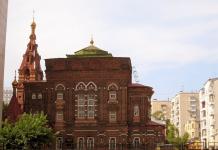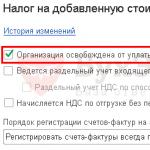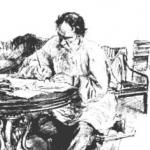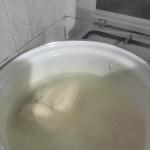On December 2, 1707, the oldest hospital in Russia received its first “poor people,” as patients were then called. On this day, the Moscow Hospital opened, now the Main Military Clinical Hospital named after. N.N. Burdenko. The first chief physician in Russia was Nicholas Bidloo, an outstanding surgeon, teacher and artist.
The only image that has reached us is the first chief physician in Russia - Nikolai Bidloo (1674-1735). He painted himself in the image of a hermit, indulging in thoughts about the past. His gaze is drawn to the estate adjacent to the hospital grounds.
This is the first drawing from the album sent by Bidloo to Holland so that his family could see how he lives in Russia. An explanation was attached to the drawings: “His Majesty [Peter I] granted me a small plot of land next to the hospital garden, where I created for myself a garden and a charming village life, indulging in this my innate taste. And since this garden, small enough, was successfully "inscribed in the landscape, he managed to please His Imperial Majesty so much that I was honored by frequent visits from the monarch, who came here both in my presence and in my absence. In my difficult and varied duties, it was my best rest."
He was recruited to serve as Peter's physician by the Russian ambassador in Amsterdam, Andrei Matveev. The diplomat wrote to the king: “I heard from the sick that he was a very skilled man.” The contract was concluded for 6 years, after which Bidloo could return home. But he remained in Russia forever.
After spending a year next to Peter, Bidloo made two discoveries:
1) there are enough good physicians around the king, although he is still young and healthy;
2) in Russia there is practically no medicine outside the army - no hospitals, no doctors, no paramedics.
Bidloo managed to prove to the Tsar that he would bring much more benefit if he organized the first hospital in the country, where at the same time the first Russian doctors could be trained. Such a hospital was built according to Bidloo's drawings, and opened on November 21 (December 2 according to the modern calendar) 1707. The first patients were “monks, students, clerks, schoolchildren, almshouses, retired soldiers from the Secret Chancellery, elderly dragoons.” There were no wounded, although the bloody Northern War was in full swing. Mainly chronicles. Over 4 years, 1996 patients were hospitalized, of whom 1026 were cured.
Drawing of the chief physician of the Moscow hospital, Nikolai Bidloo, between 1728 and 1735.
A - a new stone building of the Moscow Hospital with 32 lights for students, wards for 200 patients, and the house church of the Resurrection of Christ. The building is crowned with a gilded statue of Mercy.
The building has been preserved in its rebuilt form; now it is the Neurological building of the Burdenko Hospital.
B - Lefortovo Palace. After Lefortov's death it belonged to Menshikov, then confiscated to the treasury. During the time of Bidloo, namely in 1730, Anna Ioannovna in this palace broke the “conditions” limiting her power and again turned Russia into an absolute monarchy.
C - German settlement.
22 - house for Bidloo workers, the building closest to the hospital is the estate of the chief physician.
The hospital with 200 beds was managed by only five professional medical workers: the “archiatr”, i.e. chief physician of Bidloo, doctor Andrey Ryopken, sub-medicine, pharmacist, sub-pharmacist. The role of apprentices was performed by 50 students: the hospital was initially conceived as a clinical one.
Since neither Bidloo nor Röpken spoke Russian, Latin became the working language. Among Moscow youth, Latin was known only at the Slavic-Greek-Latin Academy, which trained educated priests.
The armed forces needed doctors, and more of them, so they put a lot of pressure on the academy. And the authorities there handed over to Bidloo those whom they wanted to get rid of - drunkards, libertines and in general everyone who was not very suitable to be priests.
Life was harder for medical students than at the academy. There were no teaching aids. An anatomical theater was equipped at the hospital, where they dissected the bodies of “vile people”, brought by the Tsar’s decree from all over Moscow. From these “scoundrels,” that is, the lower classes of society, the first skeletons in Russia were obtained, from which they studied anatomy.
There were no textbooks either. Bidloo himself wrote the first Russian medical textbook - a manual on surgery. But on medical practice and pharmacy there were only oral “lectures”, which turned out to be nothing and nothing to write down.
The hospital managed to establish ink production; in the spring, students collected goose feathers along the Yauza, where waterfowl flying from the south rested. But the paper was only imported, and it was worth, in the words of the Spanish ambassador, “more expensive than the eye.” All the students' pocket money was spent on it.
In addition to classes in the anatomical theater and clinic, the medical student periodically went on expeditions during the warm season. Throughout the Moscow region, Bidloo’s students collected medicinal plants and caught “piavits,” that is, leeches, in ditches. This activity seemed suspicious to the population, and it happened that men caught students and broke their “bottles” with “drinkers.”
In such conditions, out of the first 50 students, by the time of graduation, only 33 remained. Eight ran away, six died, two were sent somewhere, and one was given up as a soldier for theft.
Bidloo understood that everyone's abilities are different. Those who could not “surpass” medicine in 5 years studied for 10. But if a young man managed to overcome the “torture,” as the exam was called then, then Bidloo vouched for such a person to the king that he would recommend this surgeon to anyone, even His Majesty.
The first issue was sent to the armed forces. If the student completed the course in full, he was entitled to a diploma as a doctor, and then received 12 rubles a year in the army. And the one who “diligently practiced surgery and performed various operations, and responded kindly to torture in surgery and medicine,” received a doctor’s diploma on parchment, and his salary was 120 rubles.
In 1712, two of Bidloo's favorite students - Stepan Blazhenev and Ivan Belyaev - were enlisted as doctors in the Baltic Fleet. These are the first certified doctors with Russian surnames. Before them, the fleet was staffed only by foreign doctors. They immediately organized general torture for Bidloo graduates, first in the academic and then in the literal sense.
The assembled doctors passionately chased Blazhenev and Belyaev through all areas of medicine, gave them unsatisfactory marks in general medicine and pharmaceuticals, noting their lack of reliability in surgery. And then they beat me brutally.
Bidloo complained to the fleet commander, Admiral General Apraksin, and his students were left alone. But the same thing happened to graduates of the school at the Moscow hospital, wherever they appeared. Senior European doctors either beat them, or refused to consider them doctors, or kept them with them as servants.
Foreign colleagues have long said to Nikolai Bidloo: “You cannot teach medicine to the people of this people.” In their opinion, all Russians are by nature drunkards and slobs, and if someone shows ability, then there is still nothing to teach him, so as not to raise competitors.
But Bidloo refused to “impossibly do it.” He warned Peter in a letter that such vile stories “will destroy all the disciples’ hunt and Your intention ....” This appeal was read on March 18 (27), 1715 in the Senate under the Tsar, and he decided that no foreign doctor or doctor should “dare to show any offense to the graduates of the Bidloo school.” At the same time, he also prohibited the opposite - giving preference over foreigners to Russian doctors just because they are one of their own.
General view of the estate of the chief physician of the Moscow hospital Nikolai Bidloo around 1730.
In the foreground is the Yauza River, to the right of the estate is the hospital territory. The main alley from Soldatskaya Sloboda (on present-day Gospitalny Val Street) to Yauza divides the estate in half. To the left of the estate is the field where Bidloo grew bread.
11 - a pond with a bosquet labyrinth arranged around it, which gave an echo that Peter I loved to listen to.
12 - the gate through which the head physician entered the hospital territory from his estate.
13 - summer house Bidloo.
Drawing by N. Bidloo.
View from the fence of the estate of the chief physician of the Moscow hospital Nikolai Bidloo up the Yauza (Bidloo’s house and the hospital are behind the viewer).
Drawing by N. Bidloo, between 1728 and 1735.
Author's explanations:
A - Pokrovskoye [Bogorodskoye]
B - Preobrazhenskaya Sloboda
C - Semenovskaya Sloboda
D - meadow beyond the Yauza River
E - Yauza River
F - "The grain that I have sown"
G - "The building where wheat is dried, called here the barn"
H - "A current in an open field, arranged according to local custom."
Do you know what is the oldest hospital in Moscow and Russia?
I didn’t know until I read on the Internet that the Main Military Clinical Hospital named after Academician N.N. Burdenko in Moscow is the oldest medical institution in Russia. This is the first hospital that was established in Russia by decree of Peter the Great on May 25 (old style) 1706.
On this day, Peter I gave a decree to the boyar Ivan Alekseevich Musin-Pushkin “...to build a hospital beyond the Yauza River opposite the German Settlement in a decent place for the treatment of sick people. And for that treatment, Dr. Nikolai Bidloo, and two doctors... and from foreigners and from Russians, from all ranks of people, recruit 50 people for pharmaceutical science...”
But I want to talk about the 4th City Hospital of Moscow, which will celebrate its 250th anniversary this fall. It ranks second in seniority and follows the Burdenko Hospital.
"City Clinical Hospital No. 4 was founded in 1763 by decree of Empress Catherine II in honor of the recovery of the heir to the throne, Paul, who was seriously ill. The country yard of A. I. Glebov, General Kriegs Commissioner, who was owes the treasury more than 200 thousand rubles. The hospital was officially opened on September 14, 1763. It consisted of several wooden buildings, but in 1784, after the main hospital building burned down, thanks to Pavel, a large stone building was built. Architect Kazakov built the building palace type, reminiscent of the Golitsyn hospital (currently the 1st City Clinical Hospital).
The hospital ensemble included the main building with a church in the center, which was consecrated in memory of the apostles Peter and Paul. Since 1830, the hospital ensemble began to be rebuilt, and the architect Domenico Gilardi erected two wings, which created a front courtyard in front of the main building. The Central 4th Mountain Hospital of Moscow is constantly expanding and updating. Old buildings are being renovated and new additional buildings are being built. Today, many buildings of the 4th City Clinical Hospital are architectural monuments of the 18th and 19th centuries. Outstanding medical figures worked in this hospital." 4-city-hospital.rf
“So, the first chief physician was Dr. Leclerc, then this position was occupied by Erasmus, Haas, Leventhal. Also, in various years, professors Rein, Mortsinovsky, Damir, Vinogradov, Yukhtin, Chadayev and others worked at the hospital.” mosgorzdrav.ru/mgz/KOMZDRAVin…
Currently, the 4th Moscow City Hospital is a multidisciplinary medical institution, which includes a hospital and a district clinic. The hospital has 30 buildings of different heights on an area of 13 hectares, as well as a significant scientific center. Since 1904, teaching and scientific activities have been carried out in the hospital. The hospital houses 9 departments of three medical universities in the capital (MMA, RGMU and RUDN University).
My son was once examined in this hospital, and now my husband is being examined.
In my opinion, this is not the worst medical institution in Moscow. And what do you think?
Photo 1913 by P. P. Pavlova. Gynecological building named after. A.P. and E.V. Kaverins. On the left you can see the temple in honor of the icon of the Mother of God “Joy of All Who Sorrow.” View from 3rd Meshchanskaya Street.
Modern view (the angle is slightly different, so the church is not visible, but it is there).
In connection with the plague epidemic (1770 - 1773), by a special decree of Catherine II, an anti-plague quarantine was organized on 3rd Meshchanskaya Street (now Shchepkina Street) - “Quarantine Houses” (1772 - 1773). On this base in 1775, also by decree of the Empress, a hospital was created, named after its founder Catherine. Considering the Highest patronage, it was also called the “Catherine Imperial Hospital”. This was the second hospital in Moscow for the civilian population after the Pavlovsk Hospital (now the 4th City Hospital), established in 1763 with 25 beds.
Photo 1913 by P. P. Pavlova. General form.
The hospital was intended for the "unskilled working class of people" and was initially housed in 13 separate wooden buildings. It had 150 beds, an almshouse for 100 people, a workhouse for men, and a nursing home for former military personnel. The subsequently created medical institutions in various districts of Moscow were branches (departments) of the Catherine Hospital.
In 1826-1833 Another hospital was organized at the Petrovsky Gate (now the 24th city hospital), which separated from Ekaterininskaya and received the name Novo-Ekaterininskaya, and the former one retained the name Staro-Ekaterininskaya. In 1876, the former branches also received the status of separate hospitals: Myasnitskaya, Yauzskaya, Basmannaya, Preobrazhenskaya, Aleksandrovskaya.
Photo from the 1920s. Church of the Icon of the Mother of God "Joy of All Who Sorrow". View from almost the same place as the first photo. The gynecological building is behind the edge of the photo on the right.
The temple was erected in 1896–1899 according to the design of architect. V. P. Desyatov at the expense of the manufacturer A. P. Kaverin at the Staro-Catherine Hospital. The temple was founded on the occasion of the wedding and coronation of Nicholas II. Built in Russian-Byzantine style. In 1924 the temple was closed.
The five-domed structure and the bell tower tent have been demolished. The building was used as MONICA's office space. Divine services were resumed in 1997. At the church there is the sisterhood of St. Luke (Voino-Yasenetsky).
Photo gray 1980s

Photo from 2010. Modern look. Modern photos here and below are mine.

Photo 2010
Photo 1913 by P. P. Pavlova. Maternity hospital named after S. T. Morozov.
The building of the maternity shelter with 74 beds was built at the expense of Sergei Timofeevich Morozov in 1909 (architect A.I. German).
It was in this maternity hospital that V.S. Vysotsky was born.
Modern look.
Photo from 1985. Same.
Photo 1913 by P. P. Pavlova. Office, emergency room and outpatient clinic named after. L.I. Timister. Built at the expense of a major manufacturer and benefactor Leonid Ivanovich Timister (1900s, architect I.A. Ivanov-Shits). View from the corner of Samarskaya Street and Orlovsky Lane.
Modern look.
Photo con. 1950s - early 1960s E. P. Solovyova. View from the same point, but the lens is aimed at Orlovsky Lane. MONICA's buildings are on the right.
Modern look.
At the beginning of the 20th century. The Staro-Ekaterininskaya Hospital was the largest medical institution in Moscow, where up to 15 thousand patients received inpatient treatment annually, and 30 thousand received outpatient treatment.
In total, by 1917, the Old Catherine Hospital consisted of fifteen buildings.
In 1923, the hospital received institutional status in connection with the transformation into MKI - Moscow Clinical Institute for Advanced Medical Training, and in 1930, after the formation of the Moscow region, it received the name MOKI - Moscow Regional Clinical Institute. The main function of the institution was postgraduate training of doctors. In 1943, the final status of the institution was established - MONIKI, Moscow Regional Research Clinical Institute.
Photo 1998 Greenlynx. View from the 13th floor from MONICA's window. In the foreground is the MONICA complex.

Photo from 2010. The second hospital church, wooden - in honor of the icon of the Mother of God "Healer" (consecrated on May 22, 1881). There was an anatomical theater (morgue) attached to it. After the revolution the church was closed. Used as a morgue.
And poetic lines from A. Manu:
“Fire in the hospital. Brave guys
People were quickly escorted out of the building.
Medical staff in soiled gowns
Crowds around the smoke-filled doors.
Standing higher on the extra bed,
The fire chief announces to the doctors:
"No harm done! Although in the annex
We found two that were completely bad.
But it’s not for nothing that we trained the guys!
Well, they see - the men are completely screwed.
They still pumped it out in about ten minutes...”
There was deathly silence.
“Why are you upset, doctors?
Everyone is alive - I say it again!”
Then a quiet voice came from the crowd:
“Milok, the annex is our morgue!”
Pavlovsk (fourth city) hospital. Photo: www.mosgorzdrav.ru
Exactly 250 years ago, on September 25, 1763, by decree of Catherine II, the first public hospital was opened in Moscow..
Pavlovsk hospital
The history of the appearance of the first “people's” hospital is as follows: in 1762, Catherine II arrived in Moscow for her coronation. She was accompanied by her son Pavel, who suddenly fell seriously ill. The best doctors were called in to treat the heir. Everything worked out well, and in memory of Pavel Petrovich’s deliverance from illness, it was decided to open a hospital for the poor in Moscow.
The hospital, called "Pavlovskaya", was located in wooden buildings in the country estate of General Glebov, transferred to the treasury for debts. Initially there were 25 beds for the sick, but already in 1766 a large wooden building with a church and 2 outbuildings for employees was built. In 1784, this building burned down, and other buildings became very dilapidated. In 1807, a large stone palace-type building with 3 floors was built.
Gradually the number of beds for patients increased and new premises were required. In 1829, 2 more stone outbuildings and 2 buildings for apartments for doctors, officials, clergy and staff were erected here. Later, even a conference room was set up, where portraits of the hospital’s founder, chief directors and managers were placed. In February 1904, by order of Nicholas II, training courses for orderlies were organized at the hospital, which marked the beginning of teaching activities. Now on the territory of the former Pavlovsk Hospital there are City Clinical Hospital No. 4, as well as the Department of Internal Medicine and General Physiotherapy of the Pension Faculty of the Pirogov Russian National Research Medical University.
Military hospital
And the oldest state medical institution in Moscow was founded in 1706. The “military hospital” was headed by Nikolai Bidloo, a Dutch doctor who had previously been the personal physician of Peter I. The main building of the hospital, which has survived to this day, was built in 1798-1802 according to the architect’s design Ivan Egotov. Now the Main Military Hospital named after Burdenko is located there.

Main military hospital named after Burdenko. Photo: ITAR-TASS
During the Patriotic War of 1812, the hospital received over 17 thousand wounded and sick, and during the First World War - about 400 thousand. Over three hundred years, almost 4 million people were treated at the hospital. Nikolai Sklifosovsky, Nikolai Pirogov and other famous Russian doctors worked here.
The hospital was not only a medical institution, but also an educational one: the first school in Russia for training doctors, as well as the first anatomical center, appeared here.
Catherine Hospital
Catherine II established another people's hospital in 1776 in the building of the former quarantine yard on 3rd Meshchanskaya Street. A decree issued on this occasion addressed to the Moscow chief of police, Nikolai Arkharov, read: “Considering that among those wandering around the world and begging in this city, there are elderly, crippled and sick people who are not able to feed themselves by their labors, and also do not belong to anyone people for whom no one cares, we, out of our natural love for humanity, decided to establish a special hospital and almshouse under the authority of the local police ... "

The historical building of the Novo-Ekaterininskaya Hospital. TASS photo chronicle, 1948
In 1833, the hospital moved to a building on the corner of Petrovka and Strastnoy Boulevard and became known as Novo-Ekaterininskaya. It was the largest medical institution in Moscow, there were 250 beds, and people of all ranks were served, the poorest of them were provided with treatment free of charge. In 1866, the Yauzsky department appeared at the Catherine Hospital, and in 1876, the Basmanny department, which later became independent hospitals. In 1871, a paramedic and midwifery school was opened on the basis of the clinic. In 1909, at the expense of the Morozovs, a maternity hospital was built here, and a little later the first tuberculosis department in Moscow.
Golitsyn Hospital
The third, after Pavlovsk and Catherine, hospital for poor citizens was opened in Moscow in 1802. Prince Dmitry Mikhailovich Golitsyn bequeathed to build it with all his accumulated capital in memory of his early deceased wife Ekaterina Golitsyn. After the death of the prince, his cousins Alexander and Mikhail began construction of hospital buildings on the banks of the Moscow River. Also, the wife of Paul I, Empress Maria Feodorovna, took part in the construction of the folk hospital, attracting famous architects Vasily Bazhenov and Matvey Kazakov to the project.
Representatives of all segments of the population, except serfs, were admitted to the Golitsyn hospital for free treatment. In 1802, the hospital had 50 beds, and in 1805 - already 100. Additionally, in 1803, an almshouse for incurable patients with 30 beds was opened at the hospital.

Golitsyn Hospital, now City Clinical Hospital No. 1. Photo: ITAR-TASS, 1954
It is known that Christian Ivanovich Tsinger (grandfather of the mathematician, botanist and philosopher Vasily Yakovlevich Tsinger) served as the housekeeper (manager) of the hospital at the beginning of the 19th century for many years. During the Patriotic War of 1812, when Moscow was occupied by Napoleon's troops, he remained alone in the hospital and managed to prevent its looting, and also saved the hospital money left for his safekeeping. For conscientious service, Christian Ivanovich received the title of hereditary nobleman
Until the mid-19th century, all the chief doctors of the hospital were professors at Moscow University, and the hospital was the clinical base of the Faculty of Medicine. Now in the buildings of the former Golitsyn hospital there is city clinical hospital No. 1.
Sheremetevskaya Hospital

Sklifosovsky Research Institute (Sheremetevsk Hospital). Photo: ITAR-TASS, 1968
And the history of the famous Sklifosovsky Research Institute began in 1803 with a “hospital home” founded for charitable purposes by Count Nikolai Petrovich Sheremetev. The house consisted of a hospital with 50 beds and a shelter for 25 orphan girls. During the Patriotic War of 1812, the building of the Hospice House housed a hospital, first for the French and then for the Russian army, and later - a hospital for those wounded in the Russian-Turkish War of 1887. The wounded from the fronts of the Russian-Japanese and the First World War were also received here. In 1923, the Institute of Emergency Care was organized on the basis of the Sheremetyev Hospital.
Of course, other hospitals were opened in Moscow in the 18th and early 19th centuries, but we only talked about those that continue to operate today.




















